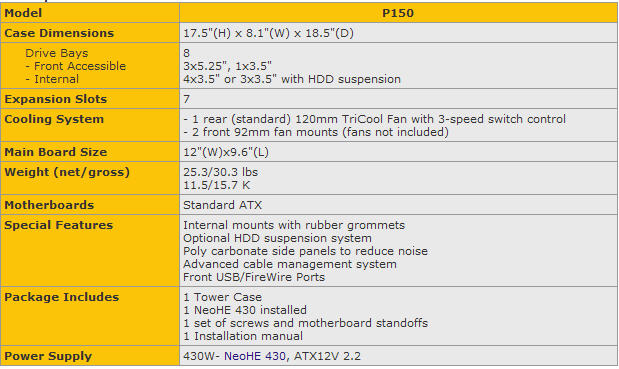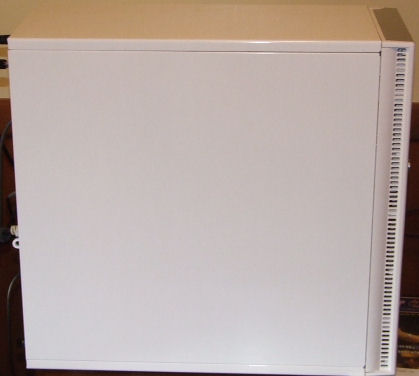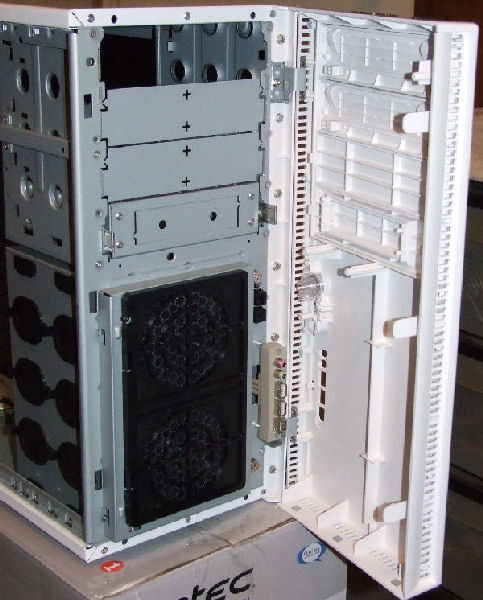Today we are going to take an in-depth look at Antec’s P150 Case; the newest member of its Performance One line of computer enclosures. In this review, we hopefully will answer most if not all of your questions about whether this case is right for you.
INTRODUCTION
Antec® has long been known as one of the top two or three case builders in the world amongst “Computer Enthusiasts.” As of late, Antec’s emphasis has shifted away from that of building a case that is designed solely for performance to more of a blend of performance coupled with quieter and less obtrusive operation. Antec, like many of its competitors, has endeavored to accomplish this task by moving to fewer yet larger fans that move more air but are substantially quieter than their smaller counterparts.
Air movement alone does not sell cases! For a case to sell, it must also have an external design that is appealing to potential buyers meshed with an internal function that also meets the current and perceived future needs of the market that it services. We all know that an object’s looks and style are in the eyes of the beholder, and cases are certainly no exception. I think if most “Computer Enthusiasts” were totally honest, they’d list the following order of preference for cases: 1) Looks and style; 2) Functionality; 3) Price; and 4) The potential longevity of the product based on impending technology changes of the components it will house.
Today we are going to an in-depth look at Antec’s P150 Case; the newest member of its Performance One line of computer enclosures. In this review, we’ll focus on determining how well this case fits each of the above captioned criteria which hopefully will answer most if not all of your questions about whether this case is right for you.
FEATURES & SPECIFICATIONS
Features
These captioned features place this product in the mid-tower range of cases; probably one of the most popular lines of c
- Sound-deadening side and top panels reduce noise
- 120mm TriCool™ selectable-speed fan (installed) – allows you to optimize cooling and quietness
- High Efficiency 430-Watt ATX12V v2.2 Neo HE power supply
- Quiet, energy-efficient operation (up to 85%) reduces power consumption and saves you money
- Precise ±3% power regulation
- Dedicated power circuitry delivers more reliable output
- Triple +12V outputs isolate CPU power circuits from other peripherals
- Universal Input (100 – 240 VAC) with Active PFC
- Advanced cable management reduces system clutter and improves internal airflow
- Integrated cable organizers help keep your system neat
- 4 removable HDD bays; or use optional HDD suspension system (included) for up to 3 hard drives
- Front-mounted ports for easy multimedia connections
- 2 x USB 2.0
- 1 x IEEE 1394 (FireWire®, i.Link®)
- Audio In and Out
- Removable side panel with easy-access thumb screws
- Removable front bezel for easy access to drive bays
- Blue LEDs on front for Power On and HD indicators
- Fits Micro ATX (9.6″ x 9.6″) and Standard ATX (12″x 9.6″) motherboards
- Dimensions: 17″(H) x 8.1″(W) x 18.5″(D) 43,0cm (H) x 20,5cm (W) x 46,8cm (D)
Specifications

As with many cases the external 3.5″ floppy drive slot can be easily converted to a fourth 5.25″ slot simply by opting to remove the floppy drive bay.
PACKAGING
Once again, Antec® meets this author’s expectations by securely packaging their precious cargo. The case I received for evaluation was not only packaged in the original packing; it was double boxed to further protect the contents. This is a huge plus to not only me but also to most consumers. There is nothing more frustrating than to receive your valued case or any product for that matter that is shipped to you, only to find a ding, scrape, or other damage resultant from rough handling during its journey to your door step.

A CLOSER LOOK – EXTERNAL
First Impressions
Immediately upon removing this case from its shipping container(s) and even before removing the plastic sheeting, I was completely taken back by its beautiful high-gloss pearl white paint job. I had seen pictures of this case on web sites prior to its arrival and I must say none do it justice as compared to the real thing. After removing the balance of the packing materials I was able to see the brushed aluminum bezel which ever so nicely accents the paint job. Although many will certainly argue the point that black is a much more visually appealing color scheme for a case, I’m a big fan of either white or silver. Combining the two, in the case of the P150 (no pun intended), makes for one of the best looking color combinations I’ve seen in the past five years.
External Views
Notice the clean cut lines of the front bezel. To the right is the power switch with a nicely sized reset button immediately below it. The power switch is well illuminated by a bright blue LED. Just below the two buttons are the front-mounted ports for multimedia connections consisting of 2 x USB 2.0 ports, 1 x IEEE 1394 (FireWire®,) port, and an audio in and out port. To the left of this array of controls is a nicely placed hard drive LED which is also bright blue in color.
The top two 5.25″ bays have bay covers that are hinged offering the option of both hiding and protecting two optical drives. Depending on your tastes a flush mount of the optical drives is also easily achievable by removing the bay covers and adjusting according your mounting point(s) on the drive rails.

The rear of the case shows the well engineered grill for the 120mm Triflo™ which is included with this case. The size of the grill openings is optimal for excellent airflow with very little resistance to create turbulence. A hasp styled locking device is attached to both the case and the left door to facilitate manually locking the case against intrusion. Slots for up to seven PCI/PCI-E cards are also provided.

This view of the left door again emphasizes the beauty of the high luster pearl white paint job. It also shows the ventilation slots cut from top to bottom in the side of the bezel to optimize airflow. Although not shown, the case is sitting on four solid rubber feet that serve to further minimize any vibrations the case may undergo during daily operation.
A CLOSER LOOK – INTERNAL
Front View

Opening the hinged front bezel is a snap. After removing the left side door release the tension on the three plastic retaining clips and the bezel swings open to the right. Notice that the bezel is mounted on steel hinges that allow for fluid movement as well as easy removal of the bezel. The lower front of the case contains the front fan cage which is also hinged and held in place by two thumb screws. The cage is easily removed and designed to hold up to two 92mm fans. It is covered with an easily removable filter which does an excellent job of catching dust and debris before it enters the case without significantly impeding airflow.
Above are photos which show more detail of the front fan cage. The first image is of the cage removed, with the filter in place. The second image shows the filter removed and the cage inverted for mounting front cooling fans. The final picture is of the cage with two 92mm Panaflo M1A fans mounted and ready for installation. Note: The red and white wire is for connection of the hard drive LED which is mounted on the front fan cage.
Once the fan cage has been removed the hard drive bays with their front access is visible. The image on the left shows the four bays with the two of the removable drive cages in place and two removed to show the optional drive suspension method for mounting your hard drives. This method is to reduce virtually all hard drive vibrations thus eliminating any associated noise. Using the suspension method limits you to being able to install only three hard drives. The center image shows one of the removable hard drive cages with the silicon grommets to reduced hard drive vibration transmitted to the case. The image on the right depicts a hard drive being hung by the suspension method.
Side View
The two images above show an interior view of both the left and right sides of the case. Antec® has gone to great lengths to make cable management easier than ever before by the inclusion of cable hooks on the right side of the case in the lower left hand corner.
A CLOSER LOOK – INTERNAL con’t.
Door Panels

Each of the interior door panels as well as the top of the case have been lined with a polycarbonate liner. The polycarbonate acts the same as sound proofing does in a music room by dampening the sound from inside the case. In theory the polycarbonate adds little if any thermal insulation to the case thus not sacrificing the cooling properties of the case in the name of making the case more environmentally friendly.
NeoHE™ 430 Power Supply
The Antec® P150 case comes equipped with their own NeoHE 430 watt modular power supply.

Attached to the power supply, you’ll find the following:
- Five 6-pin output sockets, for use with the wire sets to power your drives and other peripherals.
- 4-pin +12V connector
- A 24-pin configurable main power connector with detachable 4-pin section for 20-pin applications.
- One Y-adapter with one standard 4-pin Molex peripheral connector at one end and two female floppy power connectors at the other end.
- One set of wires with a 6-pin PCI Express graphic card connector at one end and a 6-pin PSU connector at the other end.
- Two sets of wires with three standard 4-pin Molex peripheral connectors at one end and a 6-pin PSU connector at the other end.
- Two sets of wires with two SATA drive connectors at one end and a 6-pin PSU connector at the other end. Note: The SATA connectors include a +3.3V output so you can power the latest SATA devices.
NOTE: I must state for the purpose of this review that there was a recognized problem with the early versions of this and other NeoHE™ power supplies that were distributed. In short, the vast majority of them failed to function with the nVidia® nForce4™ chipset motherboards. Antec will replace at no cost to the owner any unit that is found to have this problem with a later revision of the power supply in which the problem has been remedied.
INSTALLATION
As with most mid tower cases that do not provide a removable mother board tray space is tight and conditions are somewhat cramped. Previous to reviewing this case I had my system housed in an Antec™ SLK3000-B case, which while still midtower case is slightly roomier than the P150. To be perfectly honest because of the arrangement of the P150 and its advanced cable management system, I found the installation of my complete system in this case to be somewhat easier. Other than space limitations installation was otherwise unremarkable.

Test system installed
TESTING
Test System
- Motherboard: Intel D875PBZLK
- Processor: Intel 3.4 GHz Northwood run at default speed
- HSF: ZALMAN CNPS7000B-CU
- Video Card: ATI X800XL run at default speed
- Optical Drives:
- Plextor PX-712A
- Lite-On Model 167 DVDROM
- Hard Drives: 2- Seagate Barracuda 7200.7 120 GB SATA drives
- Memory: 1 GB (2- 512 MB sticks) Mushkin 3500 Level 2 DDRAM run at 2.75 volts
- Hard Drives: 2- Seagate 7200.7 Sata Drives (non-RAID)
- Sound Card: Turtle Beach Santa Cruz
- Fan Controller: Sunbeam 4 channel rheobus 17 watts per channel
- Case Fans-P150: Rear: Antec® Triflo™ 120mm; Front: 2- Panaflo™ M1A 92mm fans
- Case Fans-SLK3000-B: Rear: Antec™ Triflo® 120mm; Front: Antec™ Triflo® 120mm;
Test Methodology: Temperature
I thought it might be interesting to compare the cooling performance of the Antec® P150 to the of its slightly cousin the SLK3000-B. The only case fan difference in the systems current configuration is the P150 will be using two 92mm Panflo™; front intake fans while the SLK3000-B is using an Antec®TriFlo™ 120mm intake fan. For load conditions, I will run two simultaneous sessions of CPU burn in hyperthreading mode for a period of 15 minutes and test each case with the fans running at 7 volts and 12 volts. Ambient room temperature is held consistent at between 21-22 degrees celcius.
Test Results: Temperature
|
Case
|
System Temp (C)
|
CPU Temp (C)
|
||||||
|
Idle(7v)
|
Load(7v)
|
Idle(12v)
|
Load(12v)
|
Idle(7v)
|
Load(7v)
|
Idle(12v)
|
Load(12v)
|
|
| Antec® P150 |
25
|
30
|
24
|
28
|
27
|
52
|
25
|
48
|
| Antec® SLK3000-B |
26
|
32
|
25
|
30
|
28
|
57
|
26
|
52
|
The NeoHE 430 watt power supply performed flawlessly at both idle and load ranges with voltage variances never being more than + .2 volt on the 12 volt, 5 volt and 3.3 volt circuits throughout the entirety of the testing. It is also this author’s opinion that my system, which is somewhat older by today’s standards, is the maximum with regard to voltage and wattage requirements that this power supply can effectively handle. It don’t believe it would support even a minimal system running an SLI configuration. The only real negative to the power supply I noted while testing is the 80mm fan which appears speed up quite early in the temperature curve.
It should also be mentioned that throughout the testing process, my hard drives never exceeded 28 degrees Celsius.
How Quiet Is the P150?
Accurate sound pressure levels is the one area that I don’t have the necessary equipment to effectively measure. I will, however, endeavor to render a completely subjective opinion. I found this case to be substantially quieter at both the 7 volt and 12 volt ranges of fan operation than the already quiet SLK3000-B.
IMPRESSIONS & CONCLUSION
This is probably one of the more enjoyable case reviews that I’ve had the pleasure to perform. Why? Not only was it a learning experience, but it was also quite a bit of fun. The Antec®P150 is without a doubt one of the finest midtower cases on the market today. Although very good to excellent in most respects the case does have a few negatives. The MSRP for the P150 is $180.00 although many retailers have it priced in the $140 range and several vendors are currently offering a $25 rebate bring the case down into the $115 range which is certainly more palatable. I do find MSRP to be on the very high end of the spectrum even for what you receive. I would also like to see this case offered without the included power supply; which is currently not an option amongst any of the major retailers.
The P150 in the eyes of this author is one of the most stylish that I have ever seen. While as I stated earlier white or silver is my preference, I would suggest to Antec to produce a black model with similar finish to that of their Antec® Sonata™ to further satisfy customer appeal. The fit and finish of the case I reviewed is amongst the best I’ve ever experienced.
The case performed impeccably cooling my test system the best of any case I’ve ever owned or reviewed; and doing so in the quietest manner I’ve yet to find. The “Quiet Enthusiasts” would probably argue that it could be made substantially quieter by running less fans at lower voltages, but not without sacrificing the cooling performance I’ve come to expect.
I should also mention that the case is exceptionally heavy for it’s size, weighing in at 25.3 lbs. without any additional components. Fully loaded it’s closer to 40 lbs. With the weight comes added rigidity that certainly helps to enhance the system’s quiet performance. If I were designing my dream case I would take this case’s design and make it 3-4 inches taller, 2-3 inches deeper, and an inch or two wider and that’s all it would take as at that size no removable mother board tray would be necessary.
In the introduction of this review I listed what I felt to be the primary concerns of the computer enthusiast when purchasing a case: 1) Looks and style; 2) Functionality; 3) Price; and 4) The potential longevity of the product based on impending technology changes of the components it will house. I have addressed numbers 1-3 in detail in throughout this review and feel the P150 more than addresses each of these concerns Given the current state of mother board designed and the feeling that BTX has been shelved, I think it’s safe to say that the P150 also satisfies #4. That being said I heartily recommend this case to any consumer looking for a case that totally exudes quiet, cool, and stylish eloquence.
Pros:
+ Stylish and eloquent design
+ Excellent cooling performance
+ Extremely quiet operation
+ Beautiful high-gloss paint job
+ Excellent component fit and finish
+ Advanced cable management system
Cons:
– MSRP is high
– No removable motherboard tray
– No option to purchase the case without the included power supply
Final Score: 9 out of 10 and the Bjorn3D Golden Bear Award
 Bjorn3D.com Bjorn3d.com – Satisfying Your Daily Tech Cravings Since 1996
Bjorn3D.com Bjorn3d.com – Satisfying Your Daily Tech Cravings Since 1996












